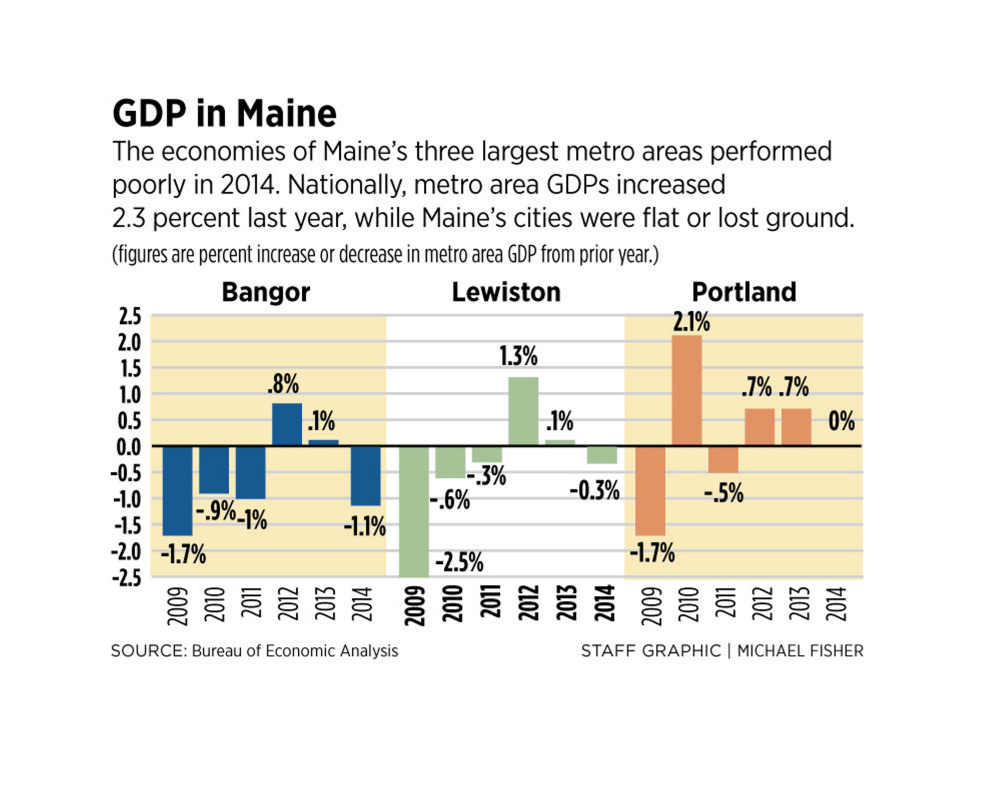Maine’s metropolitan areas continued to lag well behind the rest of the United States in economic output last year, new figures from the federal Bureau of Economic Analysis show.
Portland’s gross domestic product – the value of the metro region’s output of goods and services – was flat last year compared to 2013, the BEA said, while the average for growth in metro areas nationally was 2.3 percent. Maine’s two other metro areas did even worse, with Lewiston-Auburn posting a decline of 0.3 percent and Bangor’s economy contracting 1.1 percent.
“That’s worrisome,” said Jonathan E. Reisman, an associate professor of economics and public policy at the University of Maine at Machias.
Reisman said that, on the surface, Maine’s metropolitan economies have seemed to be in fairly good shape, despite continuing difficulties for the paper industry in more remote parts of the state.
“There’s nothing leading the economy forward, but nothing I see pulling it down,” that would explain the poor economic performance, he said.
Particularly troubling, he said, was that Maine’s three metro areas did so poorly, while Boston, where the GDP grew by 2.6 percent last year, seems to be in solid shape economically. That means Maine, particularly the southern part of the state, can’t count on Boston’s rising economy helping to pull neighboring regions up.
“We’re always the caboose of the New England economy,” he said. “Now, it seems we’re disconnected from the train.”
The three metro areas are defined as York, Cumberland and Sagadahoc counties for the Portland metro area; Androscoggin County for Lewiston; and Penobscot County for Bangor.
Economist Charles Lawton of Planning Decisions Inc. said the poor performance isn’t a surprise, given that the state’s recovery from the recession has been slow and Maine’s demographics are inhibiting growth.
He said economists have been saying for years that those demographics – Maine is the nation’s oldest state, its labor force is shrinking and it hasn’t been able to attract younger workers – would hold down growth or could cause the economy to shrink.
That’s hitting home now, he said, and is reflected in the economic performances of the metro areas that are, at best, treading water. Lawton said business owners tell him that their businesses are healthy, by and large, but they could grow much faster if they could find more workers.
“It’s hard to grow if you can’t find the employees to do the work,” Lawton said.
And, Lawton said, there’s no big change on the horizon to suggest that more robust growth is in the offing, even though Portland’s labor force – all those who are working or looking for work – has been growing in recent years. The labor forces in Bangor, Lewiston and the state as a whole have been declining in recent years. The 2015 numbers suggest that workers are moving to Portland from within the state, while census figures suggest the state is growing from in-migration only slowly.
But the value of the work of those workers hasn’t been captured in Portland’s GDP yet, which is based on 2014 data.
Reisman agreed that the shrinking labor pool in the state needs to be reversed, although he said there’s no indication it’s likely anytime soon.
“We need immigration in Maine, particularly people in their 20s and 30s,” he said.
Among the 13 business sectors detailed in the federal bureau’s report, every industry except for professional and business services, education and health care services and natural resources and mining declined in Bangor. In Lewiston, it was the same, although natural resources and mining declined while arts, entertainment, recreation, accommodations and food services, along with a catch-all “other” category, eked out minor gains.
Portland’s industry sectors were mixed, with gains in professional services, education and health care and arts, entertainment, recreation, accommodations and food services offset by a sharp decline in the finance, insurance, real estate, rental and leasing sectors.
Nationally, the Midland, Texas, metro region posted the strongest increase in GDP last year with a gain of 24.1 percent. Homosassa Springs, Florida, contracted the most, with a decline of 7.5 percent in GDP.
Overall, 282 of the nation’s 381 metro areas posted increases in GDP last year, the BEA said.
Copy the Story Link
Send questions/comments to the editors.




Success. Please wait for the page to reload. If the page does not reload within 5 seconds, please refresh the page.
Enter your email and password to access comments.
Hi, to comment on stories you must . This profile is in addition to your subscription and website login.
Already have a commenting profile? .
Invalid username/password.
Please check your email to confirm and complete your registration.
Only subscribers are eligible to post comments. Please subscribe or login first for digital access. Here’s why.
Use the form below to reset your password. When you've submitted your account email, we will send an email with a reset code.